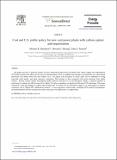Cost and U.S. public policy for new coal power plants with carbon capture and sequestration
Author(s)
Hamilton, Michael R.; Herzog, Howard J.; Parsons, John E
DownloadHamilton-2009-Cost and U.S. public.pdf (342.1Kb)
PUBLISHER_CC
Publisher with Creative Commons License
Creative Commons Attribution
Terms of use
Metadata
Show full item recordAbstract
This paper provides a financial analysis for new supercritical pulverized coal plants with carbon capture and sequestration (CCS) that compares the effects of two relevant climate policies. First, an updated cost estimate is presented for new supercritical pulverized coal plants, both with and without CCS. The capital cost escalation of recent years can be attributed to rising materials, plant supply, and plant contractor constraints. This estimate is then compared with recent estimates from public sources. Second, several current and proposed public policies relevant to CCS are presented. Finally, a financial analysis is performed to evaluate the effectiveness of two likely US carbon regulations on deploying Nth-plant CCS technology. The major conclusion is that the leading US carbon cap-and-trade bills will likely not be sufficient to deploy CCS technology in a manner consistent with a 550 ppm CO[subscript 2] stabilization scenario. A more aggressive carbon policy including CCS research, development, and demonstration must be considered to achieve this goal with significant CCS deployment.
Date issued
2009-02Department
Massachusetts Institute of Technology. Department of Economics; MIT Energy Initiative; Sloan School of ManagementJournal
Energy Procedia
Publisher
Elsevier
Citation
Hamilton, Michael R., Howard J. Herzog, and John E. Parsons. “Cost and U.S. Public Policy for New Coal Power Plants with Carbon Capture and Sequestration.” Energy Procedia 1, no. 1 (February 2009): 4487–4494.
Version: Final published version
ISSN
18766102